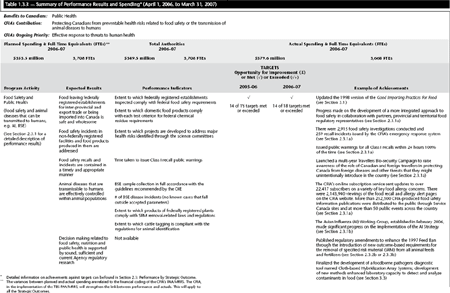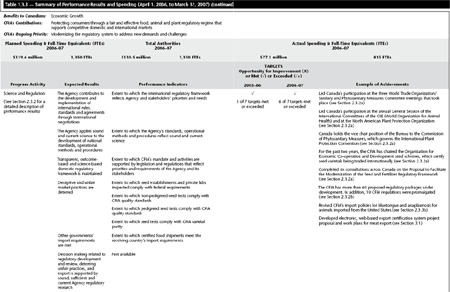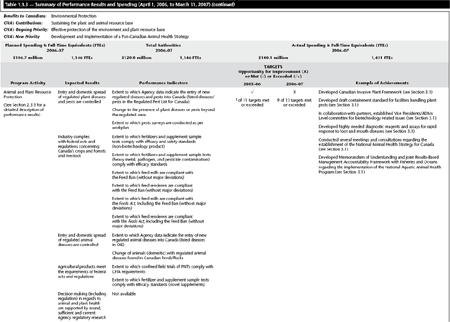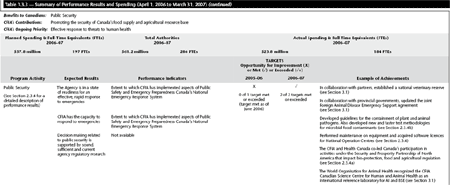Common menu bar links
Breadcrumb Trail
ARCHIVED - Canadian Food Inspection Agency
 This page has been archived.
This page has been archived.
Archived Content
Information identified as archived on the Web is for reference, research or recordkeeping purposes. It has not been altered or updated after the date of archiving. Web pages that are archived on the Web are not subject to the Government of Canada Web Standards. As per the Communications Policy of the Government of Canada, you can request alternate formats on the "Contact Us" page.
1. Agency Overview
1.1 Minister’s Message
I am pleased to submit to Parliament the Canadian Food Inspection Agency’s (CFIA) Performance Report for 2006–07. This report illustrates the CFIA’s ongoing commitment to safeguarding Canada’s food supply and its plant and animal base. This contributes to a healthy environment and economy, and the well-being of Canadians.
Throughout 2006–07, food safety and controlling the entry, emergence and spread of animal diseases and zoonotic and plant pests remained the key priorities of the CFIA, and contributed in a meaningful manner to Canada’s security and economic performance.
The CFIA, in collaboration with its public and private partners, continues to demonstrate and be recognized for its strong commitment to managing risk associated with animal diseases such as bovine spongiform encephalopathy (BSE) and avian influenza. Testament to the high level of international confidence in Canada’s regulatory regime is a recommendation by the World Organisation for Animal Health (OIE) that Canada be recognized as a BSE “controlled risk” country.
The CFIA has worked in close collaboration with federal, provincial and regulated partners as it refines and tests its emergency response plans to avian and pandemic influenza. Prevention strategies have also been high on the agenda as the CFIA has sensitized Canada’s agriculture industry to the need for enhanced biosecurity measures.
I am encouraged by the manner in which the CFIA has developed strong partner and stakeholder relationships, in both government and industry, as we continue to build an integrated, world-leading food safety, animal health and plant protection system for all Canadians.
As Minister of Agriculture and Agri-Food, I have been impressed by my portfolio team’s dedication to serving the agriculture and agri-food sector and indeed all Canadians. I have seen the advantages of teamwork on priorities such as the development of the Next Generation of Agriculture and Agri-Food Policy. I am confident this collaborative spirit will continue to be a defining feature of my portfolio as implementation of the new policy proceeds over the coming months.
I have every confidence that the CFIA, with its diligent, competent and dedicated workforce, and its strong partnerships and stakeholder relationships, will continue to excel as a science-based regulator, trusted and respected nationally and internationally.
The Honourable Gerry Ritz
Minister of Agriculture and Agri-Food and Minister for the Canadian Wheat Board
1.2 President’s Message
I am pleased to present the Canadian Food Inspection Agency’s (CFIA) Performance Report covering the period from April 1, 2006, to March 31, 2007. The CFIA is dedicated to safeguarding Canada’s food supply as well as the animals and plants upon which safe and high quality food depends. These activities contribute directly and significantly to the health and well-being of consumers, as well as the environment and the Canadian economy.
April 1, 2007, marked the 10th anniversary of the CFIA. Over the course of its first decade, the CFIA has grown in capacity and profile.
The CFIA is Canada’s largest science-based regulatory agency. For our decisions to remain objective, credible and defendable, they must be based on the best available science and a balanced consideration of other factors integral to good public policy. During the past year, we have demonstrated a balanced approach to the issues that we have faced while serving Canadians and protecting their food supply.
In 2006, we were challenged by a number of food safety incidents, including alerts for salmonella in chocolate and E. coli in spinach. The CFIA, along with its partners and industry, worked to identify, manage and minimize risks. In fall 2006, we issued several high-profile food-related hazard alerts. The CFIA’s rapid and effective response to these hazards continues to meet the expectations of Canadians.
While managing the eradication and containment of a number of plant pests of international significance, we were also challenged with the detection of a potato pest, the golden nematode, in Quebec. Together with our partners and industry, steps were taken to control its spread and to minimize the impact on the marketability of Canadian potatoes.
The ongoing implementation of the CFIA’s bovine spongiform encephalopathy (BSE) surveillance program continues to accelerate the eradication of this disease from Canada’s cattle population and to enhance the Agency’s reputation internationally. This year, for example, the World Organisation for Animal Health (OIE) designated several CFIA facilities as OIE World Reference Laboratories for BSE and avian influenza. In fact, the CFIA’s laboratory system includes 13 of Canada’s 17 international reference laboratories.
The Agency, working with its partners and stakeholders, has played throughout the year and over the past decade an important role in the life of our country. Thanks to its dedicated, competent, and professional men and women, the foundation of a proud legacy has been built.
Carole Swan
President
1.3 Summary Information
The Canadian Food Inspection Agency (CFIA) is dedicated to safeguarding food, animals and plants which enhance the health and well-being of Canada’s people, environment and economy. The CFIA serves Canadians by providing protection from preventable health risks, delivering a fair and effective regulatory regime, protecting the plant and animal resource base, and promoting the security of Canada’s food supply and agricultural resource base. In support of these activities, the CFIA is committed to effective internal management.
Note: Where targets are discussed in this document, they are indicated by the following symbol:![]() .
.
Summary of Performance in Relation to Agency Priorities
The CFIA plans for and reports on its performance based on a Program Activity Architecture that was developed and implemented in collaboration with the Treasury Board. This Performance Report outlines key performance results against four of the Agency’s five1 Strategic Outcomes, its expected results, and its established targets.
In 2006–2007, the CFIA has met or exceeded 31 of 40 (78%) targeted results compared with meeting 26 of 36 (72%) targeted results in 2005–06. The year over year increase in the number of met targets is due to one additional target being met under the Public Security Strategic Outcome, and one additional target being met under the Sustainable Plant and Resource Base Strategic Outcome. The CFIA’s compliance and enforcement policies, as well as program strategies continue to support the core mandate set out in the various statutes that the CFIA administers and enforces. In a few program areas, however, a need for improvement has been identified. In these cases, adjustments to correct the deficiencies are being made to policies and program delivery.
|
Planned Spending |
Total Authorities |
Actual Spending |
|
637.6 |
662.0 |
620.6 |
|
Source: SATURN and 2006–07 Report on Plans and Priorities. |
||
|
Planned Full-Time Equivalents (FTEs)* |
Actual FTEs |
Difference |
|
6,401 |
6,098 |
303 |
|
* The calculation of a full-time equivalent (FTE) differs from the calculation of an employee in that the former considers part-time employment, term employment, job sharing, and would combine, for instance, two-half time employees into a single FTE. |
||
|
Source: Salary Management System and 2006–07 Report on Plans and Priorities. |
||
Table 1.3.3 presents CFIA’s planned and actual spending, as well as some of the CFIA’s performance highlights for four of its Strategic Outcomes: Protection from preventable health risks related to food safety or the transmission of animal diseases to humans; security from deliberate threats to Canada’s food supply and agricultural resource base; protection of consumers through a fair and effective food, animal and plant regulatory regime that supports competitive domestic and international markets; and a sustainable plant and animal resource base. The performance highlights demonstrate the success of the plans implemented by the CFIA, as well as the CFIA’s progress toward meeting the priorities and planned outcomes to which it committed in its 2006–07 Report on Plans and Priorities (RPP). A more detailed discussion of the CFIA’s performance can be found in Section 2.
CFIA Context
CFIA Context More than 6,000 highly-trained, full-time staff are employed by the CFIA across Canada in a wide range of scientific, technical, operational and administrative positions. The staff of CFIA are involved in risk assessment, risk management, policy and program development, analytical testing, research and development, and international discussions and negotiations. They are also involved in providing certification, establishment and product inspections, sampling, monitoring and verification, as well as conducting surveillance, warnings, detentions, seizures, recalls, and other related compliance activities.
Four interrelated factors are critical to the Agency’s success in safeguarding Canada’s food supply, and the plants and animals on which safe, high-quality food depends. These are detailed below.
Sound science: The CFIA is Canada’s largest science-based regulatory agency. The CFIA’s vision is to excel as a science-based regulator that is trusted and respected by both Canadians and the international community. To achieve this vision, the CFIA regularly relies on scientific input and advice when developing, reviewing and improving regulations, international standards, and policies and programs for inspecting, testing, and responding to emergencies.
Effective regulatory base: To protect Canadian consumers and industry, as well as Canada’s trading partners, the CFIA strives to continually improve regulations and to promote sciencebased standards for world trade in food, animals, and plants. Clear, effective and enforceable regulations that are fair and consistently applied are essential tools for contributing to and achieving these public policy objectives. For example, Canada’s priorities for regulating imported and exported products are consistent with the World Trade Organization’s obligations. The CFIA also engages trading partners bilaterally and multilaterally to help Canada meet its economic objectives.
Effective inspection: Industry is ultimately responsible for doing what is necessary to meet or exceed standards established by federal legislation for food safety, animal health, and plant protection. The CFIA is responsible for administering and verifying industry compliance with federal statutes and their associated regulations by conducting inspections, audits, product sampling and verification and other activities.
Strong partnerships: Strong partnerships are central to the ability of the CFIA to achieve its Strategic Outcomes. The CFIA shares many areas of jurisdiction and responsibility with other federal departments; provincial, territorial and municipal authorities; and other stakeholders. For example, it shares responsibility for setting and enforcing standards that ensure the integrity of Canada’s food supply, animal health, and plant protection systems. In support of Agriculture and Agri-Food Canada’s Agricultural Policy Framework, the CFIA is developing and implementing regulations to control the manufacturing of medicated feeds. Working with Agriculture and Agri-Food Canada, as well as the provinces and territories, the CFIA is also implementing a program that provides government recognition of industry-developed, on-farm food safety programs.
Key federal partners of CFIA:Health Canada |
Further details on the complementary roles played by each CFIA partner are outlined in Section 2.3 — Performance by Strategic Outcome.
CFIA Operating Environment
While the CFIA delivers its programs according to its pre-established Strategic Outcomes, the agriculture and agri-food environment in which it operates is dynamic. New threats routinely emerge in biological systems, and the nature of these threats is often unpredictable. As a result, the CFIA is frequently called upon to mobilize its resources in response to emerging challenges, such as avian influenza, new cases of bovine spongiform encephalopathy, major food safety recalls, and the detection of new plant pests in Canada. It is a constant challenge for the CFIA to be able to balance prompt and appropriate responses to threats with the effective delivery of its ongoing responsibilities.
Agency Special Initiatives for 2006–07
Develop and implement a National Animal Health Strategy: Global ecosystems and economies are interconnected. While it is more difficult to invest in prevention of off-shore risks, it is no longer adequate to only manage risks once they occur on Canadian soil. The CFIA management of domestic and international animal health issues must now be conducted in an integrated manner. The focus of CFIA management in this area must also shift to strategic and proactive disease prevention. The National Animal Health Strategy is striving to achieve five key results: maintain confidence in Canada’s animal health and food safety inspection system; reduce social and economic consequences of disease detection; provide industry and regulated stakeholders with greater market access, security, predictability and competitiveness; ensure access to the best available science to support evidence-based decision making; and create better informed consumers. The development of the National Aquatic Animal Health Program (NAAHP) continues the co-operation between the federal and provincial governments. It will provide a disease control program that will be recognized by our trading partners for its efforts to prevent the spread of fish diseases in Canada. The CFIA works in partnership with Agriculture and Agri-Food Canada, as well as the provinces and territories in its efforts to develop a comprehensive National Animal Health Strategy.
Facilitate recognition of the Canadian Science Centre for Human and Animal Health (Winnipeg) as an international reference laboratory for avian influenza (AI) and bovine spongiform encephalopathy (BSE): Canada’s only safety level four containment laboratory is the Canadian Science Centre for Human and Animal Health in Winnipeg. The complex is also home to the National Microbiology Laboratory and the CFIA’s National Centre for Foreign Animal Diseases, which was approved as an international reference laboratory for AI and BSE by the World Organisation for Animal Health (OIE).
Increase security, prosperity and quality of life of North American citizens: The Security and Prosperity Partnership initiative was announced on March 23, 2005, to address North American security and economic challenges through the implementation of trilaterally agreed workplans. The CFIA and Health Canada co-lead Canada’s participation in activities that impact bio-protection and food and agricultural regulation. For example, a North American food safety co-ordinating mechanism is being developed to assess food safety standards throughout the continent. Key bio-protection initiatives led by the CFIA include: developing a co-ordinated approach to identify and manage threats to animals, plants and humans; undertaking joint emergency response drills; expanding the animal vaccine bank to respond to more animal health diseases; and jointly responding to enforcement actions.
Establish a national veterinary reserve: The CFIA is establishing a national veterinary reserve in partnership with the Canadian Veterinary Medical Association, provincial governments, provincial veterinary associations and registrars, as well as the Public Health Agency of Canada and Public Safety Canada. This initiative will build a roster of trained foreign animal disease emergency response personnel to further enhance preparedness. It will also serve to augment Canada’s ability to collaborate at the international level when addressing emerging risks at their source, without compromising its domestic operational and business continuity obligations.
Key Factors Affecting the Agency in 2006–07
The changing marketplace: The CFIA has a responsibility to ensure that Canadian food — whether exported or consumed at home — meets the demands of the marketplace. International markets have become increasingly competitive, and trading partners demand that Canada’s exports meet existing and new standards and requirements. At the same time, Canadian consumers are increasingly seeking accurate information on food labels and in advertising in order to make informed choices. Canadian consumers also expect the food supply and the environment on which it depends to continue to be safe.
Emerging animal diseases: The CFIA has had to respond quickly and adopt new methods for detecting the presence of emerging animal diseases such as the highly-pathogenic h4N1 strain of avian influenza and Viral Haemorrhagic Septicaemia (VHS), an infectious virus affecting mostly rainbow trout in the Great Lakes waters shared by Canada and the United States. Early detection of emerging diseases is critical to protect animal health in Canada and protect products destined for domestic trade and export.
Key Risks and Challenges
The CFIA’s capacity to achieve its Strategic Outcomes depends greatly on its ability — and those of its partners — to recognize, manage, and mitigate risks. In its 2006–07 Report on Plans and Priorities, the CFIA identified its key risks and challenges and set out a plan to address these issues. Key risk mitigation strategies have been identified in
Section 3.1 with the following symbol![]() .
.
Foodborne illness: Canadians have access to a food supply that is safe and nutritious. The CFIA and its regulatory partners, as well as industry and consumer groups, have worked to significantly reduce the threat of foodborne illness in Canada; however, the risk that such illness can arise will always remain. The CFIA works to manage and mitigate risks in collaboration with its partners.
Emergence and/or spread of animal diseases that affect humans (zoonoses): Animals, both domestic and wild, can transmit disease-causing agents to humans. Bovine spongiform encephalopathy, avian influenza, the spread of West Nile virus, and new strains of rabies are examples of diseases of animal origin that can affect public health (although not all of these have occurred in Canada). Incomplete scientific knowledge surrounding the nature and transmission of emerging diseases and inadequate animal and veterinary public health infrastructure in many countries only adds to the complexity of managing these diseases. The CFIA protects Canadians from these types of diseases by working in close partnership with the animal health community, livestock producers, provinces, and the international community in promoting early detection, reporting, and control of disease.
International regulatory framework: The CFIA continues to work through international institutions to help develop and operationalize international trading rules to ensure the protection of human, animal, ecosystem and plant life. For the same reasons, the CFIA promotes the development of international standards and policies that are based on sound science in other international fora. Retaining, strengthening, and reinforcing rules and science-based approaches within the international regulatory framework helps Canada achieve its regulatory objectives, and serves to protect Canadian exporters from discriminatory and unnecessary barriers.
Domestic legislative framework: Outdated statutes and/or insufficient authority could impede the CFIA’s ability to fully and effectively carry out its mandate. Inconsistencies among federal, provincial and territorial legislation also weaken the domestic legislative framework. The CFIA is pursuing mechanisms to update and modernize its legislative framework.
Entry and/or spread of regulated plant and animal pests and diseases that affect the resource base: A healthy and sustainable plant and animal resource base in Canada is critical to social objectives, the environment, and the economy. The CFIA and its partners use a number of measures to identify and reduce threats to the animal and plant resource base. These range from surveys and movement control to eradication and emergency response.
Emergency preparedness and response: The CFIA must be able to take rapid and effective action to protect food, plants, and terrestrial and aquatic animals from accidental or intentional events that could compromise their safety or integrity. To do this, the CFIA must maintain and rehearse well-planned emergency response plans and procedures in the event of international, noninternational and natural emergencies. Strong, co-operative relationships with the CFIA’s partners, including those in other countries, are critical to the success of its emergency and security measures.
Demand for new/enhanced services: Increasing demands from producers and consumers for new or enhanced services has placed additional pressure on CFIA resources. The CFIA responds to growth in domestic industries, such as the opening of new meat establishments, and the resulting increase in requests for inspection and certification of products. As well, the CFIA responds to increasing consumer concerns and needs, such as demands for better information on nutrient content and methods of production for food products.
Performance information: To better support day-to-day and strategic decision making, the CFIA must improve its performance information and develop mitigation strategies to enhance the use of performance information and data collection. Improving performance information will, through the continual improvement and development of information systems, also strengthen the CFIA’s ability to report results to Canadians.
Financial and human resources: The CFIA faces the constant challenge of managing resources so it can continue to meet ongoing activities, make strategic investments in program redesign, and cope with animal and plant health emergencies. The CFIA’s Long Term Capital Plan is designed to ensure a sustainable resource base. In addition, the CFIA conducts appropriate recruitment, retention and training practices to attract new employees and maintain staff with the appropriate skills, knowledge and abilities.
Program design: The CFIA must continue to review its program design in order to deal with technological and scientific advancements. This ongoing review focuses on achieving social and environmental objectives for human and animal health, and stewardship of the resource base, while enabling the competitiveness of Canadian agri-business. Where the service delivery requires innovative solutions, the CFIA works with stakeholders to bring these about.




